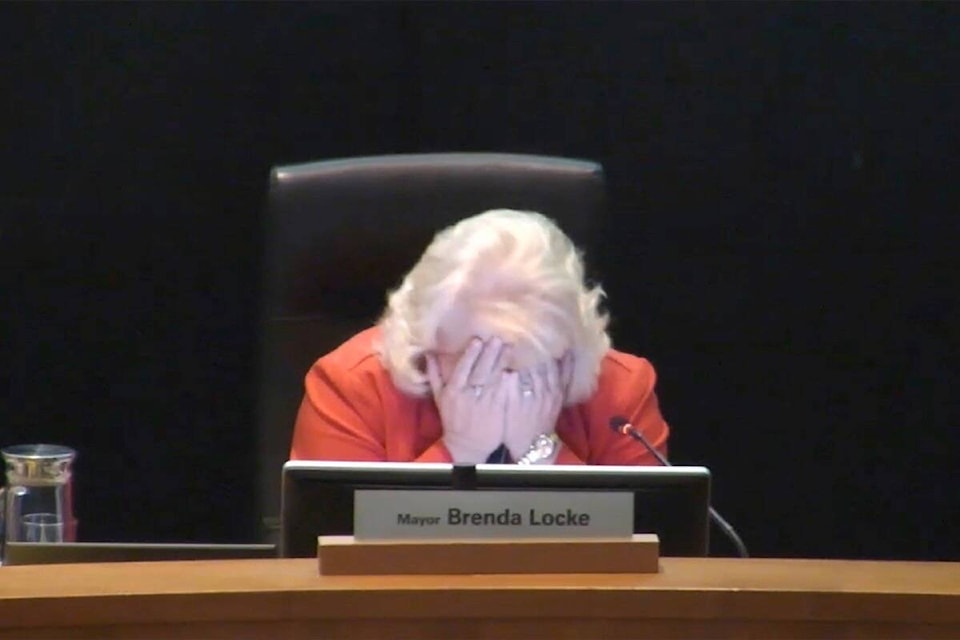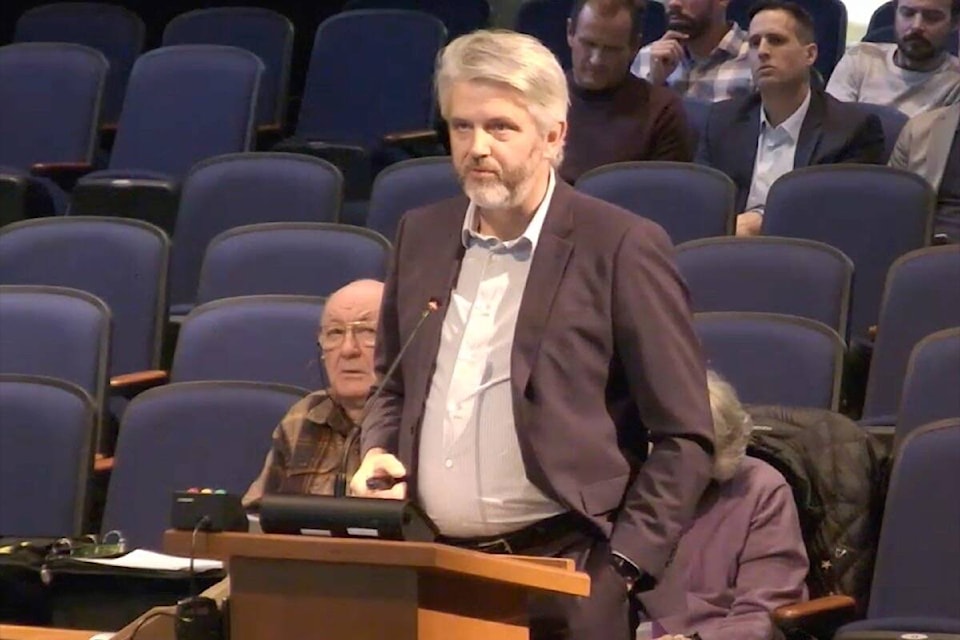City of Surrey staff characterized new provincial legislation concerning residential housing and public transit as “planning with a sledge-hammer,” rendering years of community planning and consultation at the civic level obsolete.
At one point Mayor Brenda Locke buried her face in her hands as Don Luymes, Surrey’s general manager of planning and development, broke down the good, bad and ugly of NDP bills 44, 46 and 47, each causing changes to the Local Government Act and bearing “significant” implications for Surrey.
Locke remarked that the city “better buckle up” for unexpected consequences, “because I think there’s going to be a ton of it.”
“I am very concerned and I think we all are about the pressures that already on our city with hospitals and health care, schools, social infrastructure, public transit in a city that’s already growing as fast as we are, this just seems to be something that’s going to put massive pressures on us,” she said. “I do, however, get the need to build on transit lines and corridors.”
Luymes noted that over the past few weeks a series of bills have been introduced and passed “that together represent the most significant change to land use planning in B.C. in many years, perhaps even decades.”

He explained that the legislation is driven by the objective of dramatically expanding housing supply by over-riding local government “restrictions” on land use and density.
Provincial Housing Minister Ravi Kahlon told the Now-Leader he appreciates some people “might be sensitive because they believe this implies that they’re not doing a good job, but that’s not what we’re saying. The sledgehammer is not about taking communities down, what we’re trying to do with this is build communities up.
“We have housing needs right now in our community and the bills we brought forward are not in place to ensure that there’s housing for people that may come, it’s to ensure that there’s housing for the people that are already in our communities. We have people that are underhoused, we have people that are living 12 people, 13 people to two-bedroom suites and the need is great,” Kahlon said.
Luymes told council on Dec. 4 that city staff reaction to the legislation up to this point is that it constitutes a provincial government “over-reach” into areas of municipal jurisdiction bearing good intentions, but a lot of unintended consequences.
“Frankly, it renders years of community planning and consultation I’d say obsolete as the province has come in and essentially changed the game plan,” Luymes told council. He lamented a lack of meaningful consultation with local governments, considering the magnitude of changes.
“There’s been I would say a lack of meaningful consultation with local governments considering the magnitude of the changes and not that much consideration of the infrastructure implications, for instance around school planning, sanitary sewers, road networks and the like.”
Locke said it was important that council be briefed on this and that the public understands this is “significant and impacting.”
Luymes noted Bill 44, aka the Residential Development Bill, requires civic governments to provide a 20-year forecast of Surrey’s housing needs by the end of 2024 and the city must also update its zoning bylaw “to permit ‘missing middle’ housing consistent with legislation” by June 2024. This bill “essentially permits secondary suites or accessory units, one of each, a coach house etcetera, on every single-family lot in the province,” he told council, adding the biggest challenges to Surrey will be ensuring adequate parking, tree canopy retention and infrastructure particularly related to drainage and schools.
“We’re concerned that the unpredictability of where densification will occur will make it more challenging to plan for schools and other kinds of social infrastructure,” Luymes said. Significant implications for Surrey, he explained, are that Bill 44 sets up “further regulation” with a policy manual expected to come down in a month or so permitting three, four or six housing units on every single family lot depending on its size and proximity to public transit.
READ ALSO: Surrey Mayor Brenda Locke’s State of the City Address set for Feb. 15
Under the new regime, three units will be permitted on lots smaller than 3,000 square feet, four units on lots between 3,000 square feet and one acre, and six units on lots close to frequent transit, with no parking minimums.
“Local governments will be required to amend their zoning bylaws to permit these forms of developments on all single-family lots,” Luymes said.
Bill 46 deals with development financing and Bill 47 relates to “Transit-Oriented Areas” – ie. density “rings” around transit.
This, Luymes said, will require the re-working of approved plans for the City Centre, Fleetwood, Clayton, Guildford, Newton, including infrastructure servicing plans, school projections and plans, road networks, and sanitary sewer infrastructure.
He warned it’s also likely to trigger a real estate/land assembly “frenzy” in stable single-family neighbourhoods within 400 to 800 metres of rapid transit. Local governments have until June 30, 2024 to define “Transit Oriented Areas” around rapid transit stations and bus exchanges, Surrey’s planning and development manager noted, though it’s unclear as to what constitutes “rapid transit” and “bus exchange” and how much flexibility the city will have in defining its Transit Oriented Areas.
After Luymes’s presentation. Coun. Gordon Hepner asked him what this “will look like for city staff when you now turn a lot of local residents presumably into developers, what sort of backlog are we looking at?”
“I do have some concern that there will be lots of work generated here,” Luymes replied, “but the uptake will not be as significant as perhaps anticipated.”
Hepner then asked him when it comes to transit corridors and the ability to build highrises with no parking, what sort of overflow will impact local residents?
“I would expect many developers are quite savvy about what they would need to provide in terms of parking in order to market their developments and so I have some confidence many developers will choose to build the appropriate amount of parking,” Luymes replied. “There is the potential though for developers to go light on their parking knowing that there may be capacity in the neighbourhoods around to soak up some of that use by people that live in their building. That is a concern. Of course the city does have some tools whether it’s resident permit parking or no overnight parking or limited time parking to prevent it.”
READ ALSO: Surrey council approves 20 apartment buildings project in Newton
READ ALSO: Norm Lipinski says Surrey Police Service ‘leaning forward’ to fulfill transition
Coun. Mike Bose asked how the Nicomekl and Serpentine lowlands drainage strategy will be affected.
Luymes said the impact on drainage flows in some areas could be “quite dramatic. It may not be spread equally across the city, it may be localized in certain areas and certain sub-catchments.” Scott Neuman, Surrey’s general manager of engineering, said the city will have to review all of its integrated storm water management plans for all of its watersheds, particularly those containing single-family developments. “It’s going to be quite a bit of work to do in the next six months as a start,” Neuman said, “and that’s something we’ll be coming back to council with.”
Coun. Doug Elford asked what consultation city staff will be able to have with their provincial government counterparts “over the next little while.”
Luymes replied that through the consultation period leading up to the bills being introduced “many of these concerns were expressed” not only by Surrey but other cities as well. “And yet the province has seen kind of an overriding I guess objective and haven’t seen a lot of impact of some of the comments that I’ve made and others have made about the draft legislation, so we’ll see. The proof is going to be in the pudding.”
Coun. Pardeep Kooner asked what the provincial government has to say about infrastructure, given Surrey is already lacking in schools.
“I haven’t seen anything that is specifically tied to this package of legislative changes,” the planner replied. “So there hasn’t been a corresponding recognition that oh, we’re going to need to increase school funding or funding for infrastructure by X amount. I’m expecting that the province is alive to the numbers of newcomers coming into this region.”
READ ALSO: Surrey Board of Trade wants carbon tax used to fund transit initiatives
Coun. Linda Annis observed that Surrey will require roughly 51,000 new homes in Surrey over the decade, a figure she suspects is “very conservative.”
“To me right now, there’s so many questions and what-ifs,” she said. “We’re going to have to find some place to put a lot of families.”
Surrey has processed 5,100 housing units so far this year. “In terms of the number of units we’re at the very top,” Luymes said, representing about 11,000 new residents each year. “That’s by far the lion’s share of growth in the Metro region.”
Coun. Harry Bains questioned how the city will be able to update its community plans and update its zoning bylaws by June June 30 when it takes years of planning and process to develop an Official Community Plan. “It’s not impossible,” Luymes replied. “It’ll be heavy sledding but the target is there. I’m actually confident that we can make it.”
Meantime, Kahlon stressed that it’s not just one community’s responsibility to ensure adequate housing for a growing population, but every communities responsibility and the legislation will be dispersed more evenly amongst communities.
“Surrey no doubt has seen an increase in population.”
The legislation, he said, was developed with help from “a whole host of people” from 38 communities – engineers, planners, “professionals who do this work, not elected officials but professionals to give us advise.”
Kahlon said Metro Vancouver’s reports show small-scale multi-unit housing is the “best use of our existing infrastructure to get more housing. It’s the most cost-effective way to get more housing.”
So what the government is saying, he explains, is that people can still build houses of similar size but they can have separate units, “in many cases stratified, so that you can have different scenarios, you can have multi-generational families living under one roof.”
Kahlon said the work began on this legislation in 2019, with a development approval planning review that informed its framework. “Again, I appreciate some staff may be sensitive because they think this may be a reflection on them, but it shouldn’t be. We are in a housing crisis and we need to ensure that we are building the appropriate amount of housing with the infrastructure that we have.
“This is actually good planning – I appreciate not every planner will agree, I think planners like anyone else in society, people have different opinions, but we’ve seen this become an effective way of getting housing. Auckland is one example, California, Washington State, Oregon…we’re following best practices.”
